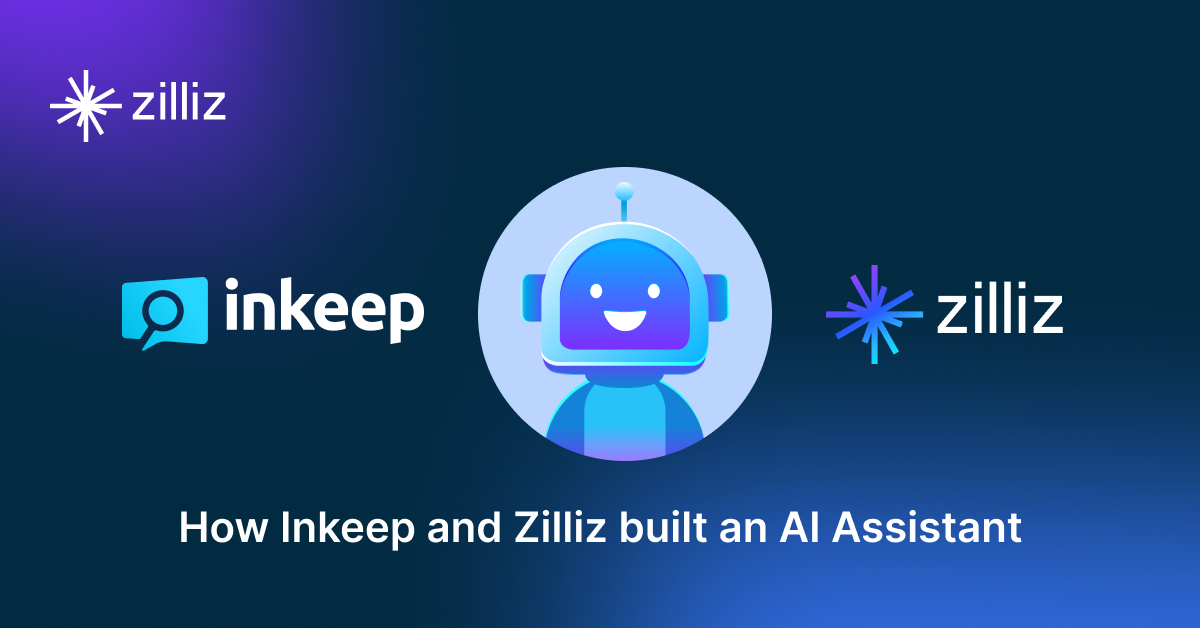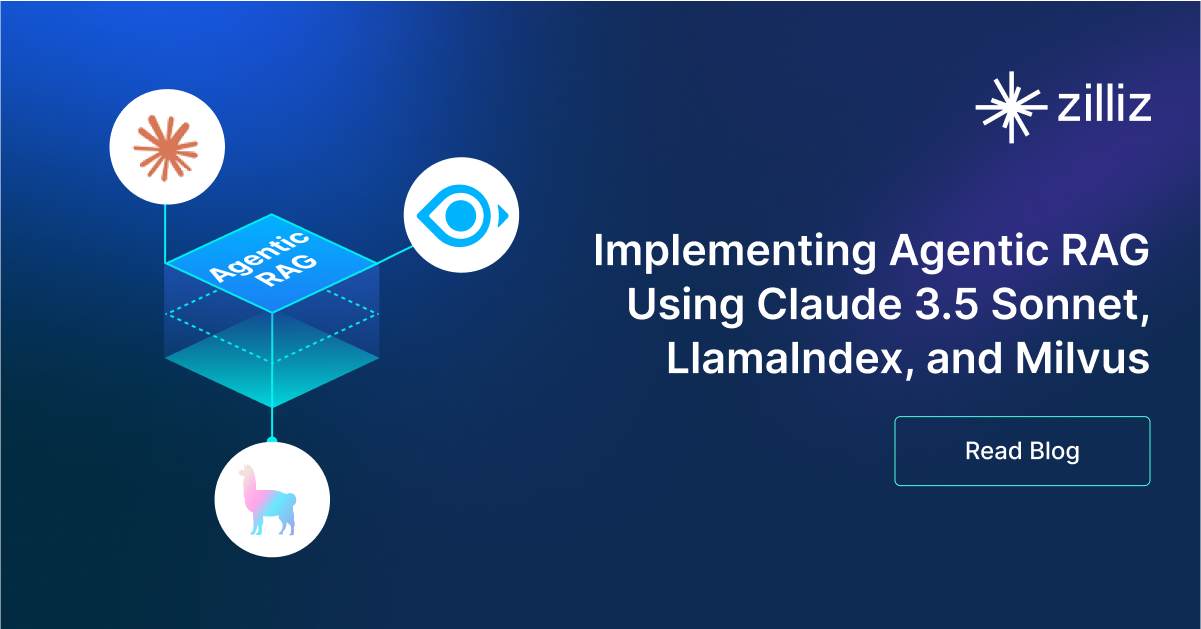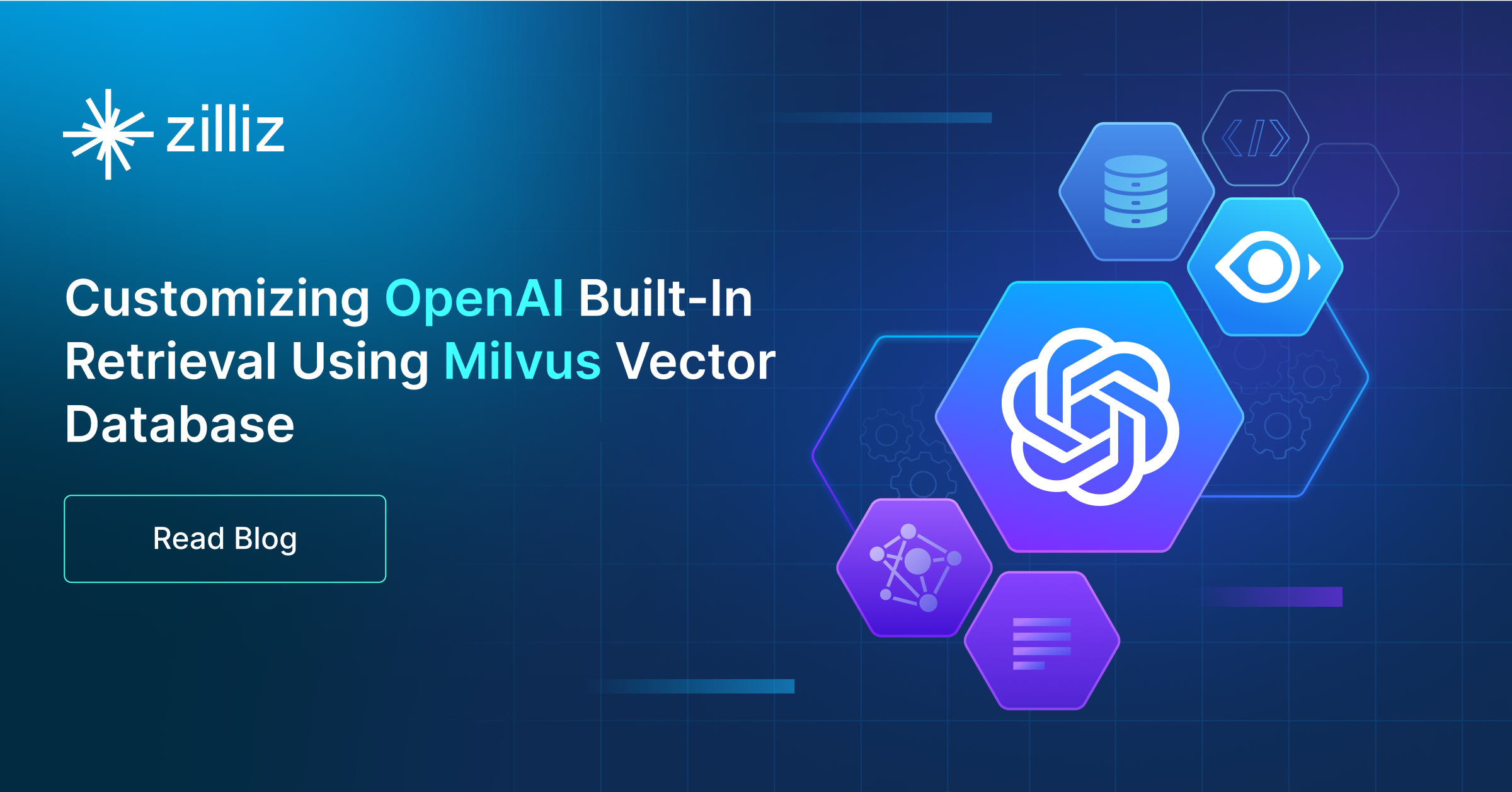Build RAG Chatbot with Haystack, Milvus, Mistral Ministral 8B, and Optimum all-mpnet-base-v2
Introduction to RAG
Retrieval-Augmented Generation (RAG) is a game-changer for GenAI applications, especially in conversational AI. It combines the power of pre-trained large language models (LLMs) like OpenAI’s GPT with external knowledge sources stored in vector databases such as Milvus and Zilliz Cloud, allowing for more accurate, contextually relevant, and up-to-date response generation. A RAG pipeline usually consists of four basic components: a vector database, an embedding model, an LLM, and a framework.
Key Components We'll Use for This RAG Chatbot
This tutorial shows you how to build a simple RAG chatbot in Python using the following components:
- Haystack: An open-source Python framework designed for building production-ready NLP applications, particularly question answering and semantic search systems. Haystack excels at retrieving information from large document collections through its modular architecture that combines retrieval and reader components. Ideal for developers creating search applications, chatbots, and knowledge management systems that require efficient document processing and accurate information extraction from unstructured text.
- Milvus: An open-source vector database optimized to store, index, and search large-scale vector embeddings efficiently, perfect for use cases like RAG, semantic search, and recommender systems. If you hate to manage your own infrastructure, we recommend using Zilliz Cloud, which is a fully managed vector database service built on Milvus and offers a free tier supporting up to 1 million vectors.
- Mistral Ministral 8B: A compact, high-efficiency language model optimized for scalable natural language processing. It excels in rapid text generation, multilingual tasks, and context-aware reasoning while maintaining low computational demands. Ideal for real-time chatbots, content summarization, and edge-device deployment where speed and resource efficiency are critical.
- Optimum all-mpnet-base-v2: A high-performance sentence-transformers model optimized for semantic textual similarity, offering robust multilingual embeddings. Its strengths include efficient inference, scalability, and state-of-the-art accuracy in tasks like semantic search, clustering, and retrieval-augmented generation (RAG). Ideal for enterprise applications requiring fast, precise text analysis across diverse languages and domains.
By the end of this tutorial, you’ll have a functional chatbot capable of answering questions based on a custom knowledge base.
Note: Since we may use proprietary models in our tutorials, make sure you have the required API key beforehand.
Step 1: Install and Set Up Haystack
import os
import requests
from haystack import Pipeline
from haystack.components.converters import MarkdownToDocument
from haystack.components.preprocessors import DocumentSplitter
from haystack.components.writers import DocumentWriter
Step 2: Install and Set Up Mistral Ministral 8B
To use Mistral models, you need first to get a Mistral API key. You can write this key in:
- The
api_keyinit parameter using Secret API - The
MISTRAL_API_KEYenvironment variable (recommended)
Now, after you get the API key, let's install the Install the mistral-haystack package.
pip install mistral-haystack
from haystack_integrations.components.generators.mistral import MistralChatGenerator
from haystack.components.generators.utils import print_streaming_chunk
from haystack.dataclasses import ChatMessage
from haystack.utils import Secret
generator = MistralChatGenerator(api_key=Secret.from_env_var("MISTRAL_API_KEY"), streaming_callback=print_streaming_chunk, model='ministral-8b-latest')
Step 3: Install and Set Up Optimum all-mpnet-base-v2
Haystack's OptimumTextEmbedder embeds text strings using models loaded with the HuggingFace Optimum library. It uses the ONNX runtime for high-speed inference. Similarly to other Embedders, this component allows adding prefixes (and suffixes) to include instructions. For more details, refer to the Optimum API Reference.
pip install optimum-haystack
from haystack_integrations.components.embedders.optimum import OptimumTextEmbedder
from haystack.dataclasses import Document
from haystack_integrations.components.embedders.optimum import OptimumDocumentEmbedder
text_embedder = OptimumTextEmbedder(model="sentence-transformers/all-mpnet-base-v2")
text_embedder.warm_up()
document_embedder = OptimumDocumentEmbedder(model="sentence-transformers/all-mpnet-base-v2")
document_embedder.warm_up()
Step 4: Install and Set Up Milvus
pip install --upgrade pymilvus milvus-haystack
from milvus_haystack import MilvusDocumentStore
from milvus_haystack.milvus_embedding_retriever import MilvusEmbeddingRetriever
document_store = MilvusDocumentStore(connection_args={"uri": "./milvus.db"}, drop_old=True,)
retriever = MilvusEmbeddingRetriever(document_store=document_store, top_k=3)
Step 5: Build a RAG Chatbot
Now that you’ve set up all components, let’s start to build a simple chatbot. We’ll use the Milvus introduction doc as a private knowledge base. You can replace it your own dataset to customize your RAG chatbot.
url = 'https://raw.githubusercontent.com/milvus-io/milvus-docs/refs/heads/v2.5.x/site/en/about/overview.md'
example_file = 'example_file.md'
response = requests.get(url)
with open(example_file, 'wb') as f:
f.write(response.content)
file_paths = [example_file] # You can replace it with your own file paths.
indexing_pipeline = Pipeline()
indexing_pipeline.add_component("converter", MarkdownToDocument())
indexing_pipeline.add_component("splitter", DocumentSplitter(split_by="sentence", split_length=2))
indexing_pipeline.add_component("embedder", document_embedder)
indexing_pipeline.add_component("writer", DocumentWriter(document_store))
indexing_pipeline.connect("converter", "splitter")
indexing_pipeline.connect("splitter", "embedder")
indexing_pipeline.connect("embedder", "writer")
indexing_pipeline.run({"converter": {"sources": file_paths}})
# print("Number of documents:", document_store.count_documents())
question = "What is Milvus?" # You can replace it with your own question.
retrieval_pipeline = Pipeline()
retrieval_pipeline.add_component("embedder", text_embedder)
retrieval_pipeline.add_component("retriever", retriever)
retrieval_pipeline.connect("embedder", "retriever")
retrieval_results = retrieval_pipeline.run({"embedder": {"text": question}})
# for doc in retrieval_results["retriever"]["documents"]:
# print(doc.content)
# print("-" * 10)
from haystack.utils import Secret
from haystack.components.builders import PromptBuilder
retriever = MilvusEmbeddingRetriever(document_store=document_store, top_k=3)
text_embedder = OptimumTextEmbedder(model="sentence-transformers/all-mpnet-base-v2")
text_embedder.warm_up()
prompt_template = """Answer the following query based on the provided context. If the context does
not include an answer, reply with 'I don't know'.\n
Query: {{query}}
Documents:
{% for doc in documents %}
{{ doc.content }}
{% endfor %}
Answer:
"""
rag_pipeline = Pipeline()
rag_pipeline.add_component("text_embedder", text_embedder)
rag_pipeline.add_component("retriever", retriever)
rag_pipeline.add_component("prompt_builder", PromptBuilder(template=prompt_template))
rag_pipeline.add_component("generator", generator)
rag_pipeline.connect("text_embedder.embedding", "retriever.query_embedding")
rag_pipeline.connect("retriever.documents", "prompt_builder.documents")
rag_pipeline.connect("prompt_builder", "generator")
results = rag_pipeline.run({"text_embedder": {"text": question}, "prompt_builder": {"query": question},})
print('RAG answer:\n', results["generator"]["replies"][0])
Optimization Tips
As you build your RAG system, optimization is key to ensuring peak performance and efficiency. While setting up the components is an essential first step, fine-tuning each one will help you create a solution that works even better and scales seamlessly. In this section, we’ll share some practical tips for optimizing all these components, giving you the edge to build smarter, faster, and more responsive RAG applications.
Haystack optimization tips
To optimize Haystack in a RAG setup, ensure you use an efficient retriever like FAISS or Milvus for scalable and fast similarity searches. Fine-tune your document store settings, such as indexing strategies and storage backends, to balance speed and accuracy. Use batch processing for embedding generation to reduce latency and optimize API calls. Leverage Haystack's pipeline caching to avoid redundant computations, especially for frequently queried documents. Tune your reader model by selecting a lightweight yet accurate transformer-based model like DistilBERT to speed up response times. Implement query rewriting or filtering techniques to enhance retrieval quality, ensuring the most relevant documents are retrieved for generation. Finally, monitor system performance with Haystack’s built-in evaluation tools to iteratively refine your setup based on real-world query performance.
Milvus optimization tips
Milvus serves as a highly efficient vector database, critical for retrieval tasks in a RAG system. To optimize its performance, ensure that indexes are properly built to balance speed and accuracy; consider utilizing HNSW (Hierarchical Navigable Small World) for efficient nearest neighbor search where response time is crucial. Partitioning data based on usage patterns can enhance query performance and reduce load times, enabling better scalability. Regularly monitor and adjust cache settings based on query frequency to avoid latency during data retrieval. Employ batch processing for vector insertions, which can minimize database lock contention and enhance overall throughput. Additionally, fine-tune the model parameters by experimenting with the dimensionality of the vectors; higher dimensions can improve retrieval accuracy but may increase search time, necessitating a balance tailored to your specific use case and hardware infrastructure.
Mistral Ministral 8B optimization tips
To optimize Mistral Ministral 8B in RAG setups, ensure input prompts are tightly formatted with clear context-question separation using [INST] tags. Use smaller retrieval chunks (256-512 tokens) to reduce noise and improve relevance. Adjust the temperature (0.1-0.3) for deterministic, fact-focused outputs. Employ a hybrid retrieval approach (dense + sparse methods) to balance precision and recall. Prune retrieved documents with cross-encoder re-rankers before feeding to the model. Limit input context length to avoid truncation, and fine-tune the model on domain-specific data for better alignment. Enable flash attention and quantization (e.g., 4-bit) to reduce latency and memory usage.
Optimum all-mpnet-base-v2 optimization tips
To optimize Optimum all-mpnet-base-v2 in a RAG setup, preprocess input text by trimming redundant whitespace, normalizing casing, and splitting long documents into smaller chunks (≤512 tokens) to align with the model’s max sequence length. Use batch processing for embeddings to leverage GPU parallelism, adjusting batch size based on GPU memory. Quantize the model via ONNX Runtime or FP16 precision for faster inference. Cache frequently accessed embeddings to reduce recomputation, and pair with efficient vector search libraries (e.g., FAISS) for low-latency retrieval. Regularly update and prune the document corpus to maintain relevance.
By implementing these tips across your components, you'll be able to enhance the performance and functionality of your RAG system, ensuring it’s optimized for both speed and accuracy. Keep testing, iterating, and refining your setup to stay ahead in the ever-evolving world of AI development.
RAG Cost Calculator: A Free Tool to Calculate Your Cost in Seconds
Estimating the cost of a Retrieval-Augmented Generation (RAG) pipeline involves analyzing expenses across vector storage, compute resources, and API usage. Key cost drivers include vector database queries, embedding generation, and LLM inference.
RAG Cost Calculator is a free tool that quickly estimates the cost of building a RAG pipeline, including chunking, embedding, vector storage/search, and LLM generation. It also helps you identify cost-saving opportunities and achieve up to 10x cost reduction on vector databases with the serverless option.
 Calculate your RAG cost
Calculate your RAG cost
What Have You Learned?
By diving into this tutorial, you’ve unlocked the power of combining cutting-edge tools to build a robust RAG pipeline! You now understand how Haystack acts as the glue, seamlessly orchestrating workflows between components while handling everything from document preprocessing to query routing. You’ve seen Milvus shine as a high-performance vector database, effortlessly scaling to manage dense embeddings and lightning-fast similarity searches. The Optimum all-mpnet-base-v2 embedding model transformed your raw text into rich numerical representations, capturing semantic meaning with precision, while Mistral Ministral 8B stepped in as your creative LLM powerhouse, generating human-like responses grounded in retrieved context. Together, these tools demonstrated how RAG balances factual accuracy with generative flair—no more “hallucinations” ruining your answers! Plus, you picked up pro tips like optimizing chunking strategies, tuning retrieval thresholds, and even using model quantization to slash inference costs without sacrificing performance. And let’s not forget the free RAG cost calculator—your new secret weapon for balancing performance and budget!
But this is just the beginning. Imagine what you can build now: chatbots that truly understand niche domains, research assistants that synthesize insights from massive datasets, or customer support systems that wow users with speed and accuracy. The tools are in your hands, and the possibilities are limitless. So go ahead—experiment with hybrid search, tweak those hyperparameters, or plug in your own datasets. Every iteration brings you closer to mastering the art of intelligent systems. The future of AI-driven applications is yours to shape. Start building, keep optimizing, and let your creativity run wild. The next breakthrough RAG app? It’s waiting for you to bring it to life! 🚀
Further Resources
🌟 In addition to this RAG tutorial, unleash your full potential with these incredible resources to level up your RAG skills.
- How to Build a Multimodal RAG | Documentation
- How to Enhance the Performance of Your RAG Pipeline
- Graph RAG with Milvus | Documentation
- How to Evaluate RAG Applications - Zilliz Learn
- Generative AI Resource Hub | Zilliz
We'd Love to Hear What You Think!
We’d love to hear your thoughts! 🌟 Leave your questions or comments below or join our vibrant Milvus Discord community to share your experiences, ask questions, or connect with thousands of AI enthusiasts. Your journey matters to us!
If you like this tutorial, show your support by giving our Milvus GitHub repo a star ⭐—it means the world to us and inspires us to keep creating! 💖
- Introduction to RAG
- Key Components We'll Use for This RAG Chatbot
- Step 1: Install and Set Up Haystack
- Step 2: Install and Set Up Mistral Ministral 8B
- Step 3: Install and Set Up Optimum all-mpnet-base-v2
- Step 4: Install and Set Up Milvus
- Step 5: Build a RAG Chatbot
- Optimization Tips
- RAG Cost Calculator: A Free Tool to Calculate Your Cost in Seconds
- What Have You Learned?
- Further Resources
- We'd Love to Hear What You Think!
Content
Vector Database at Scale
Zilliz Cloud is a fully-managed vector database built for scale, perfect for your RAG apps.
Try Zilliz Cloud for Free


